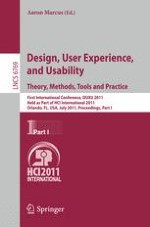The two-volume set LNCS 6769 + LNCS 6770 constitutes the proceedings of the First International Conference on Design, User Experience, and Usability, DUXU 2011, held in Orlando, FL, USA in July 2011 in the framework of the 14th International Conference on Human-Computer Interaction, HCII 2011, incorporating 12 thematically similar conferences. A total of 4039 contributions was submitted to HCII 2011, of which 1318 papers were accepted for publication. The total of 154 contributions included in the DUXU proceedings were carefully reviewed and selected for inclusion in the book. The papers are organized in topical sections on DUXU theory, methods and tools; DUXU guidelines and standards; novel DUXU: devices and their user interfaces; DUXU in industry; DUXU in the mobile and vehicle context; DXU in Web environment; DUXU and ubiquitous interaction/appearance; DUXU in the development and usage lifecycle; DUXU evaluation; and DUXU beyond usability: culture, branding, and emotions.
